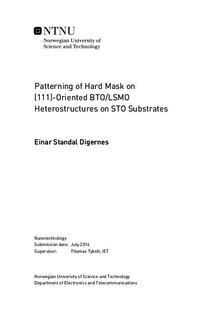Patterning of Hard Mask on (111)-Oriented BTO/LSMO Heterostructures on STO Substrates
Master thesis
Permanent lenke
http://hdl.handle.net/11250/2421688Utgivelsesdato
2016Metadata
Vis full innførselSamlinger
Sammendrag
Functional oxides exhibit properties that make them interesting for futureelectronic devices. Thin films of functional oxides can be routinely produced, butthere lacks a standard technique for establishing nanoscale freestanding structureson insulating substrates. The nanostructures must be well defined and maintainbulk properties.
In this work a recipe for establishing a two layer hard mask suitable for ion beametching (IBE) has been developed. A chromium hard mask is patterned anddeposited using electron beam lithography (EBL) and lift off. The pattern istransferred to an underlying carbon layer by oxygen reactive ion etching (RIE).
Hard masks with hallbar patterns have been structured on 5 × 5 mm sampleswith thin films of La0.7Sr0.3MnO3 (LSMO) and BaTiO3 (BTO) on (111)-orientedSrTiO3 (STO) substrates. The hallbars have widths from 11 µm and down to130 nm, which are connected to 200 × 200 µm contacts pads.
A bilayer mask of PMMA and MMA with a total thickness of 240 nm is found towork successfully for lifting off 20 nm of chromium. Samples are prone to chargingduring electron beam lithography. Fine features are written using 100 pA beamcurrent, while large features are defined at 10 nA.
The hard mask patterned samples are prepared for IBE, which will transfer thehard mask pattern into the oxide thin film and substrate, realizing freestandingoxide structures. Followed by deposition of contacts and wirebonding, the devicescan be used to investigate electrical transport properties.
